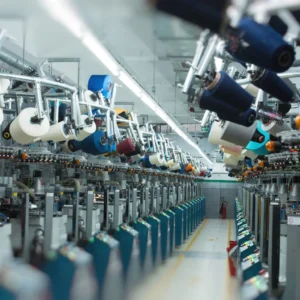
Streamlining Manufacturing Processes
Exploring the Role of IPA in Manufacturing Sector
Use Cases, Advantages, and Challenges
Get ready to revolutionise your manufacturing game with IPA tools! In this exhilarating blog, we’ll unravel the wonders of intelligent process automation, robotic wizards, business rule geniuses, and more. Explore how these cutting-edge technologies supercharge manufacturing productivity, efficiency, and quality.
From predictive maintenance to streamlined workflows, we’ll showcase real-world use cases that will blow your mind. Buckle up for an epic journey as we dive deep into the significance of BPA tools and their transformative impact. Get ready to unleash the full potential of your manufacturing processes!
Table of Contents

Arindam Roy
An Automation Consultant with 25+ years of IT Experience
Intelligent Process Automation (IPA) in Manufacturing: Unleashing Efficiency, Quality, and Agility
Definition and Key Components of IPA: Revolutionizing Manufacturing Operations
Discover the transformative power of Intelligent Process Automation (IPA) in manufacturing. Delve into the intricacies of IPA, including machine learning, artificial intelligence, and cognitive technologies, and witness how they converge to redefine manufacturing excellence.
Use Cases of IPA in the Manufacturing Sector: Fuelling Growth and Innovation
Predictive Maintenance and Asset Management: Proactive Strategies for Optimal Performance
Explore how IPA leverages data analytics and predictive algorithms to enable predictive maintenance, minimise downtime and optimise asset utilisation. Maximise efficiency and extend equipment lifespan with intelligent maintenance strategies.
Quality Control and Inspection: Zero Defects, Zero Compromises
Witness IPA’s prowess in quality control and inspection processes. Employ computer vision and pattern recognition algorithms to ensure impeccable product quality, streamline inspections, and eliminate defects, boosting customer satisfaction.
Supply Chain Optimisation: Streamlining the Journey
Unleash IPA’s capabilities to optimise supply chain operations. Seamlessly integrate data from various sources to enhance visibility, automate procurement, and minimise inventory carrying costs, resulting in a lean and agile supply chain.
Demand Forecasting and Inventory Management: Staying Ahead of the Curve
Embrace IPA’s forecasting capabilities to predict demand patterns and optimise inventory levels accurately. Optimise production schedules, reduce stockouts and eliminate excess inventory, all while meeting customer demands with precision.
Advantages of IPA in Manufacturing: Empowering Success
Increased Efficiency and Productivity: Streamlining Operations
Experience the accelerated pace of manufacturing processes with IPA. Automate mundane tasks, minimise manual errors, and unlock significant time savings, allowing your workforce to focus on higher-value activities and driving productivity to new heights.
Improved Quality and Compliance: Raising the Bar
Ensure impeccable quality standards and compliance with IPA’s intelligent automation. Detect anomalies, enforce standard operating procedures, and maintain regulatory compliance effortlessly, safeguarding your brand reputation and customer trust.
Enhanced Decision-making and Agility: Real-time Insights, Real-time Success
Harness the power of data-driven insights with IPA. Leverage real-time analytics and actionable intelligence to make informed decisions, adapt swiftly to market dynamics, and capitalise on emerging opportunities, securing your competitive edge.
Challenges and Considerations for Implementing IPA in Manufacturing: Overcoming the Hurdles
Data Integration and Security: Safeguarding the Digital Nervous System
Address the challenges of integrating diverse data sources and ensuring data security and privacy. Establish robust data governance frameworks and deploy advanced cybersecurity measures to protect your digital infrastructure.
Workforce Adaptation and Training: Empowering the Human-Machine Collaboration
Prepare your workforce for the paradigm shift brought by IPA. Facilitate upskilling and reskilling programs to equip employees with the necessary expertise to collaborate effectively with intelligent automation systems.
Scalability and System Complexity: Future-proofing Manufacturing Operations
Plan for scalability and manage the complexities associated with implementing IPA at an enterprise level. Develop a robust roadmap, ensure interoperability with existing systems, and embrace flexible architectures that accommodate future growth.
Business Rules Engines in Manufacturing: Empowering Precision, Flexibility, and Compliance
Definition and Key Components of Business Rules Engines: The Architects of Manufacturing Intelligence
Unlock the realm of Business Rules Engines (BREs) and witness how they orchestrate manufacturing intelligence. Delve into the foundational elements of BREs, including rule repositories, inference engines, and decision models, reshaping the manufacturing landscape.
Use Cases of Business Rules Engines in the Manufacturing Sector: Driving Operational Excellence
Production Planning and Scheduling: Mastering the Art of Efficiency
Experience the prowess of BREs in production planning and scheduling. Witness how rule-based engines optimise production timelines, allocate resources and synchronise operations, streamlining manufacturing processes for maximum efficiency.
Demand Forecasting and Pricing: Precision in Market Dynamics
Explore how BREs revolutionise demand forecasting and pricing strategies. Leverage rules-based engines to analyse market data, predict demand patterns, determine optimal pricing structures, and stay ahead in dynamic market landscapes.
Quality Control and Compliance: Elevating Standards, Ensuring Compliance
Harness the power of BREs in quality control and compliance. Watch as rule-based engines enforce quality parameters, ensure adherence to regulations, and automate compliance processes, safeguarding product integrity and regulatory compliance.
Warranty and Returns Management: Seamless Customer Experience
Witness the transformative impact of BREs in warranty and returns management. Experience automated rule-driven processes that handle warranty claims streamline returns, and enhance customer satisfaction, optimising post-sales operations.
Advantages of Business Rules Engines in Manufacturing: Pioneering Decision-Making and Compliance
Improved Decision-making and Efficiency: Rule-Based Precision
Experience the precision of BREs in decision-making. Leverage rule-based engines to analyse complex scenarios, automate decision-making processes, and optimise manufacturing operations, enhancing efficiency and productivity.
Greater Adaptability and Customisation: Empowering Tailored Solutions.
Harness the adaptability of BREs to meet unique manufacturing requirements. Watch as rule-based engines facilitate dynamic rule customisation, enabling manufacturing processes to evolve seamlessly and address specific business needs.
Enhanced Compliance and Risk Management: Airtight Controls, Reduced Risks
Witness how BREs strengthen compliance and risk management. Embrace automated rule enforcement, real-time monitoring, and proactive risk mitigation, ensuring adherence to regulations, minimising errors, and protecting brand reputation.
Challenges and Considerations for Implementing Business Rules Engines in Manufacturing: Overcoming the Complexity
The Complexity of Rule Management: Taming the Rule Jungle
Navigate the challenges of managing complex rules. Implement effective rule governance strategies, establish rule versioning mechanisms, and streamline rule maintenance processes to ensure accuracy and efficiency.
Integration with Existing Systems: Bridging the Technological Divide
Overcome integration hurdles when implementing BREs. Develop robust integration strategies, establish seamless communication channels with existing systems, and leverage integration frameworks to maximise the value of rule-based engines.
Continuous Rule Monitoring and Optimisation: Evolving Rules for Continuous Improvement
Ensure continuous rule monitoring and optimisation to keep pace with evolving manufacturing dynamics. Implement rule monitoring frameworks, leverage analytics to identify rule performance gaps, and facilitate iterative rule enhancements for ongoing improvement.
Robotic Process Automation (RPA) in Manufacturing: Unleashing Efficiency, Precision, and Scalability
Definition and Key Components of RPA: Empowering Manufacturing Automation
Uncover the transformative power of Robotic Process Automation (RPA) in the manufacturing sector. Dive into the fundamental elements of RPA, including software robots, artificial intelligence, and cognitive capabilities, and witness how they redefine manufacturing processes.
Use Cases of RPA in the Manufacturing Sector: Streamlining Operations, Amplifying Results
Order Processing and Invoicing: Swift and Error-Free Transactions
Experience the speed and accuracy of RPA in order processing and invoicing. Watch as software robots effortlessly handle repetitive tasks, extract data from multiple systems, generate invoices, and ensure seamless transactional processes.
Data Entry and Documentation: Unlocking Data Precision
Witness the precision of RPA in data entry and documentation. See how software robots extract information from various sources, populate databases, and streamline documentation, eliminating errors and enhancing data integrity.
Report Generation and Analysis: Insights at Your Fingertips
Embrace RPA’s capabilities in report generation and analysis. Watch as software robots retrieve data, generate reports, perform data analysis, and deliver actionable insights, empowering decision-makers with real-time information.
Inventory Tracking and Management: Optimising Supply Chain Efficiency
Unleash the power of RPA in inventory tracking and management. Witness how software robots automate inventory updates, monitor stock levels, trigger replenishment processes, and optimise inventory turnover, enhancing supply chain efficiency.
Advantages of RPA in Manufacturing: Empowering Performance and Adaptability
Cost Reduction and Increased Efficiency: Automating to Maximise Resources
Experience the cost-saving benefits of RPA in manufacturing. Witness reduced manual efforts, streamlined processes, and optimised resource allocation, improving operational efficiency and significant cost reductions.
Error Reduction and Quality Assurance: Ensuring Precision at Every Step
Witness RPA’s impact on error reduction and quality assurance. See how software robots meticulously execute tasks, minimising human errors, ensuring compliance with standard operating procedures, and delivering consistent quality outputs.
Scalability and Flexibility: Accommodating Business Growth
Harness the scalability and flexibility offered by RPA. Watch as software robots adapt to fluctuating workloads, handle increased volumes, and accommodate business growth, enabling manufacturing operations to scale effortlessly.
Challenges and Considerations for Implementing RPA in Manufacturing: Overcoming the Roadblocks
Identifying Suitable Processes for Automation: Finding the RPA Sweet Spots
Navigate the challenges of identifying processes ideal for RPA implementation. Evaluate criteria such as rule-based tasks, transactional nature, and frequency to identify strategies that yield maximum benefits when automated.
Integration with Legacy Systems: Bridging the Technology Gap
Overcome the hurdle of integrating RPA with legacy systems. Develop integration strategies, leverage connectors, and ensure seamless communication between software robots and existing infrastructure to maximise efficiency.
Security and Compliance Risks: Safeguarding Data and Processes
Address security and compliance risks associated with RPA implementation. Implement robust access controls, encryption, and audit trails to protect sensitive data, ensuring compliance with industry regulations and standards.
Workflow Automation Tools in Manufacturing: Revolutionizing Efficiency, Collaboration, and Transparency
Definition and Key Components of Workflow Automation Tools: Empowering Manufacturing Agility
Unleash the power of Workflow Automation Tools in manufacturing and witness the transformation of operational efficiency. Explore the foundational elements of these tools, including process automation, task management, and workflow orchestration, reshaping the manufacturing landscape.
Use Cases of Workflow Automation Tools in the Manufacturing Sector: Driving Productivity and Coordination
Order Fulfilment and Tracking: Orchestrating Seamless Operations
Experience the seamless orchestration of order fulfilment and tracking through workflow automation. Witness how these tools streamline order processing, automate task assignments, and provide real-time visibility into order status, ensuring timely delivery and customer satisfaction.
Production Line Coordination: Syncing Operations for Optimal Output
Optimise production line coordination with workflow automation tools. Watch as tasks are automated, resources are efficiently allocated, and production schedules are synchronised, reducing cycle times and enhancing productivity.
Supply Chain Collaboration: Harmonizing Efficiency across the Chain
Embrace workflow automation tools to facilitate smooth supply chain collaboration. Experience streamlined communication, automated data sharing, and synchronised workflows among suppliers, manufacturers, and distributors, driving supply chain efficiency and responsiveness.
Maintenance and Repair Processes: Enabling Swift Resolution
Witness the power of workflow automation in maintenance and repair processes. See how these tools automate task assignments, trigger maintenance requests, and streamline communication, ensuring timely repairs, reducing downtime, and optimising asset utilisation.
Advantages of Workflow Automation Tools in Manufacturing: Empowering Streamlined Operations
Streamlined and Transparent Processes: Orchestrating Efficiency
Experience the streamlined efficiency of workflow automation tools. Witness transparent workflows, automated task handoffs, and real-time visibility into process status, enabling faster decision-making and optimised resource allocation.
Reduced Cycle Time and Bottlenecks: Unleashing Operational Agility
Embrace workflow automation tools to eliminate bottlenecks and reduce cycle time. Experience accelerated task execution, seamless handoffs, and optimised process flow, driving operational agility and faster time-to-market.
Improved Communication and Collaboration: Catalysing Teamwork
Witness enhanced communication and collaboration facilitated by workflow automation tools. Enable seamless information sharing, automated notifications, and centralised documentation, fostering teamwork and effective cross-functional collaboration.
Challenges and Considerations for Implementing Workflow Automation Tools in Manufacturing: Embracing Change and Integration
Process Mapping and Standardisation: Paving the Path to Automation
Address the challenges of process mapping and standardisation when implementing workflow automation tools. Streamline workflows, identify process gaps, and establish standardised procedures to optimise seamless automation and process.
Integration with Existing Systems and Equipment: Bridging the Technological Divide
Overcome integration challenges when implementing workflow automation tools. Develop robust integration strategies, establish data connectivity with existing systems and equipment, and leverage interoperability to ensure smooth automation across the manufacturing landscape.
Change Management and Employee Adoption: Nurturing a Culture of Automation
Facilitate change management and employee adoption of workflow automation tools. Provide comprehensive training, communicate the benefits of automation, and foster a culture that embraces technological advancements, ensuring a successful transition to automated workflows.
Low-Code and No-Code Platforms in Manufacturing: Accelerating Innovation, Collaboration, and Customization
Definition and Key Components of Low-Code and No-Code Platforms: Igniting Manufacturing Creativity
Unleash the power of Low-Code and No-Code Platforms in manufacturing, igniting a revolution in application development. Explore the core elements of these platforms, including visual interfaces, pre-built modules, and drag-and-drop functionalities, empowering manufacturing innovation.
Use Cases of Low-Code and No-Code Platforms in the Manufacturing Sector: Empowering Agility and Efficiency
Custom Application Development: Unleashing Manufacturing Creativity
Experience the limitless potential of custom application development with Low-Code and No-Code Platforms. Witness the rapid creation of tailored manufacturing applications, enabling digital transformation and efficiently addressing unique business needs.
Prototyping and Testing: Fueling Innovation and Optimisation
Leverage Low-Code and No-Code Platforms for rapid prototyping and testing. Experience the agility to iterate designs, simulate processes, and validate concepts, accelerating innovation and ensuring optimal manufacturing outcomes.
Process Automation and Optimisation: Streamlining Efficiency, Unleashing Productivity
Explore how Low-Code and No-Code Platforms automate and optimise manufacturing processes. Witness the drag-and-drop configuration of workflows, seamless integration with systems, and automation of manual tasks, driving efficiency and productivity.
Data Visualisation and Reporting: Insights Unleashed, Decisions Empowered
Embrace Low-Code and No-Code Platforms to unlock powerful data visualisation and reporting capabilities. Experience the creation of interactive dashboards, real-time analytics, and comprehensive reports, empowering data-driven decision-making across the manufacturing landscape.
Advantages of Low-Code and No-Code Platforms in Manufacturing: Fostering Innovation and Collaboration
Rapid Application Development and Deployment: Speeding Manufacturing Transformation
Experience the speed and agility of Low-Code and No-Code Platforms. Witness accelerated application development cycles, rapid deployment, and seamless updates, enabling manufacturing organisations to stay ahead in a dynamic market landscape.
Empowering Citizen Developers: Unleashing Manufacturing Creativity
Empower citizen developers with Low-Code and No-Code Platforms. Watch as business users drive innovation by creating applications tailored to their unique needs, fostering a culture of continuous improvement and streamlining IT collaboration.
Enhanced Collaboration between IT and Business Teams: Bridging the Gap, Amplifying Success
Witness the synergy between IT and business teams through Low-Code and No-Code Platforms. Experience seamless collaboration, clear communication, and shared ownership, resulting in faster application delivery, improved alignment, and more significant business outcomes.
Challenges and Considerations for Implementing Low-Code and No-Code Platforms in Manufacturing: Navigating the Path to Customization
Integration with Legacy Systems and Data Sources: Bridging the Digital Divide
Overcome integration challenges when implementing Low-Code and No-Code Platforms. Develop robust integration strategies, ensure compatibility with legacy systems and data sources, and establish data connectivity to harness the full potential of the platforms.
Security and Compliance Risks: Safeguarding Manufacturing Integrity
Address security and compliance risks associated with Low-Code and No-Code Platforms. Implement stringent security measures, ensure data privacy, and establish compliance controls to protect sensitive manufacturing data and uphold industry regulations.
Balancing Customization and Maintainability: Sustaining Manufacturing Innovation
Strike a balance between customisation and maintainability in Low-Code and No-Code development. Embrace modular design, establish effect best practices, and adopt scalability frameworks to ensure future-proof applications while maximising customisation options.
Conclusion
In conclusion, the significance of IPA tools in the manufacturing sector cannot be overstated. From intelligent process automation to workflow automation, these tools streamline operations, enhance decision-making, and fuel growth. We explored their diverse use cases, from predictive maintenance to supply chain optimisation, each delivering tangible benefits.
Increased efficiency, improved quality, and enhanced agility are just a few advantages AI-Powered Process Automation tools offer. However, challenges like data integration and workforce adaptation must be addressed. It’s time to unlock the full potential of AI-Powered Process Automation tools and revolutionise your manufacturing processes. Embrace automation, optimise operations, and embark on a journey towards improved manufacturing efficiency and unparalleled success.
Related Articles
- AI in Paper Manufacturing: Pulp and Processors
- AI in Agri-Equipment Manufacturing: Fields and Functions
- AI in Footwear Manufacturing: Steps Ahead
- AI in Jewellery Manufacturing: Gems and Generative Models
- AI in Glass Manufacturing: Crystal Clear Computing
- AI in Construction Material Manufacturing: Bricks and Bytes
- AI in Chemical Manufacturing: Molecular Models
- AI’s Role in Electronic Manufacturing: Circuitry and Systems
- AI’s Revolution in Polymer Production: Reshaping Plastics
- AI in Furniture Manufacturing: Crafted by Code
- AI in Ceramic Production: Fired by Future
- AI in Food Manufacturing: Savory Systems
- AI in Metal Fabrication: Moulded by Machines
- AI in Aerospace Manufacturing: Beyond the Atmosphere
- AI’s Integration in Pharmaceutical Manufacturing: Pills and Processes
- AI in the Automotive Industry: Driving Production
- Weaving AI into Textile Manufacturing: Threads and Tech





















